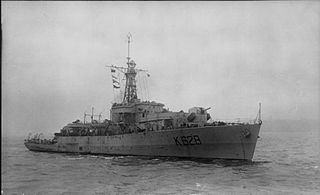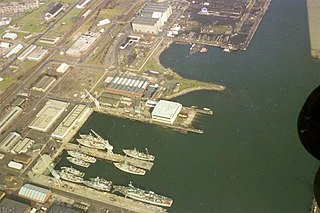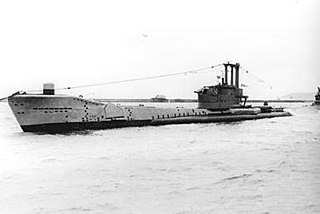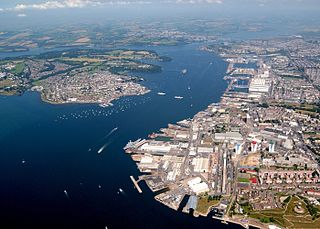
HMS Warrior is a 40-gun steam-powered armoured frigate built for the Royal Navy in 1859–1861. She was the name ship of the Warrior-class ironclads. Warrior and her sister ship HMS Black Prince were the first armour-plated, iron-hulled warships, and were built in response to France's launching in 1859 of the first ocean-going ironclad warship, the wooden-hulled Gloire. Warrior conducted a publicity tour of Great Britain in 1863 and spent her active career with the Channel Squadron. Obsolescent following the 1873 commissioning of the mastless and more capable HMS Devastation, she was placed in reserve in 1875, and was "paid off" – decommissioned – in 1883.

HMS Illustrious was a light aircraft carrier of the Royal Navy and the second of three Invincible-class ships constructed in the late 1970s and early 1980s. She was the fifth warship and second aircraft carrier to bear the name Illustrious, and was affectionately known to her crew as "Lusty". In 1982, the conflict in the Falklands necessitated that Illustrious be completed and rushed south to join her sister ship HMS Invincible and the veteran carrier HMS Hermes. To this end, she was brought forward by three months for completion at Swan Hunter Shipyard, then commissioned on 20 June 1982 at sea en route to Portsmouth Dockyard to take on board extra stores and crew. She arrived in the Falklands to relieve Invincible on 28 August 1982 in a steam past. Returning to the United Kingdom, she was not formally commissioned into the fleet until 20 March 1983. After her South Atlantic deployment, she was deployed on Operation Southern Watch in Iraq, then Operation Deny Flight in Bosnia during the 1990s and Operation Palliser in Sierra Leone in 2000. An extensive re-fit during 2002 prevented her from involvement in the 2003 Iraq War, but she was returned to service in time to assist British citizens trapped by the 2006 Lebanon War.

HMS Loch Killisport (K628/F628) was a Loch-class frigate of the British Royal Navy, named after Loch Killisport in Scotland. Launched in 1944, the ship was not commissioned until July 1945, and served in post-war repatriation operations in the Far East until decommissioned in April 1946. During this time Prince Philip was an officer on board this ship. Recommissioned in 1950 she served in the Home Fleet for two years, before being extensively modernised for service in the Persian Gulf and Far East. Decommissioned in August 1965, she was sold for scrapping in 1970.

Rosyth is a town in Fife, Scotland, on the Firth of Forth. Scotland's first Garden City, the town is located 3 miles south of Dunfermline city centre and 10½ miles northwest of Edinburgh city centre.

HMS Cavalier is a retired C-class destroyer of the Royal Navy. She was laid down by J. Samuel White and Company at East Cowes on 28 March 1943, launched on 7 April 1944, and commissioned on 22 November 1944. She served in World War II and in various commissions in the Far East until she was decommissioned in 1972. After decommissioning she was preserved as a museum ship and currently resides at Chatham Historic Dockyard.

The Commander-in-Chief Fleet (CINCFLEET) was the admiral responsible for the operations of the ships, submarines and aircraft of the British Royal Navy from 1971 until April 2012. The post was subordinate to the First Sea Lord, the professional head of the Naval Service. In its last years, as the Navy shrank, more administrative responsibilities were added.

HMS Bronington was a Ton-class minesweeper of the Royal Navy, launched on 19 March 1953. This mahogany-hulled minesweeper was one of the last of the "wooden walls".

Rosyth Dockyard is a large naval dockyard on the Firth of Forth at Rosyth, Fife, Scotland, owned by Babcock Marine, which formerly undertook refitting of Royal Navy surface vessels and submarines. Before its privatisation in the 1990s it was formerly the Royal Naval Dockyard Rosyth. Its primary role now is the dismantling of decommissioned nuclear submarines. It is also the integration site for the Royal Navy's newest aircraft carriers, the Queen Elizabeth class as well as the Type 31 Frigate.

HMS Maidstone was a submarine depot ship of the Royal Navy. She operated in the Mediterranean Sea, Indian Ocean and Pacific Ocean during the Second World War. She was later used as a barracks ship and then a prison ship in Northern Ireland.
HMS Lofoten was a vessel of the Royal Navy. Initially built as one of a large number of LSTs in 1945, she was named after the Norwegian islands that were raided during Operation Claymore in 1941. She saw little service before being laid up in reserve.

HMS Truculent was a British submarine of the third group of the T-class. She was built as P315 by Vickers Armstrong, Barrow, and launched on 12 September 1942. She sank nine enemy vessels.
HMS Swiftsure was the lead ship of her class of nuclear fleet submarines built for the Royal Navy. Entering service in 1973, she served until 1992.

HMS Alderney (P416/S66), was an Amphion-class submarine of the Royal Navy, built by Vickers-Armstrongs at Barrow and launched 25 June 1945 by Mrs Molly Wallis, wife of Sir Barnes Wallis. She was the 12th of the class and was scrapped in 1972.
HMS Powderham was one of 93 ships of the Ham class of inshore minesweepers named after villages ending in -ham, in this case Powderham in Devon. She was launched on 27 November 1958 by J. Samuel White & Company Ltd, Cowes and commissioned in 1959. She was allocated pennant number M 2720.

HMS Cattistock, the third ship of this name, is a Hunt-class mine countermeasures vessel of the Royal Navy. She was launched in 1981 and commissioned on 5 March 1982, the third ship of her class.

HMS Tudor was a British submarine of the third group of the T class. She was built as P326 at Devonport Dockyard, and launched on 23 September 1942. So far she has been the only ship of the Royal Navy to bear the name Tudor, after the Tudor period or Tudor dynasty.

His Majesty's Naval Base, Devonport is one of three operating bases in the United Kingdom for the Royal Navy and is the sole nuclear repair and refuelling facility for the Royal Navy. The largest naval base in Western Europe, HMNB Devonport is located in Devonport, in the west of the city of Plymouth, England.

The second HMS Wivern, was a Modified W-class destroyer of the British Royal Navy that saw service in World War II.

HMS Weston was a Shoreham-class sloop of the British Royal Navy. Weston was built at Devonport Dockyard in 1931–1933.

Steam Pinnace 199 is a steam pinnace of the Royal Navy, built in 1909 by J. Reid of Portsmouth. She is now owned by the National Museum of the Royal Navy, and is based at Portsmouth Historic Dockyard.


















